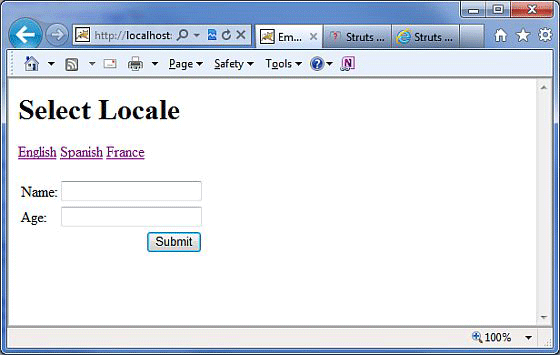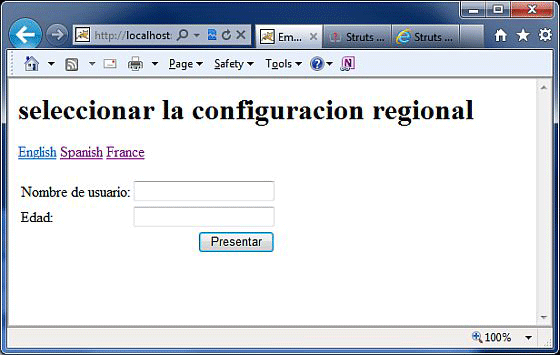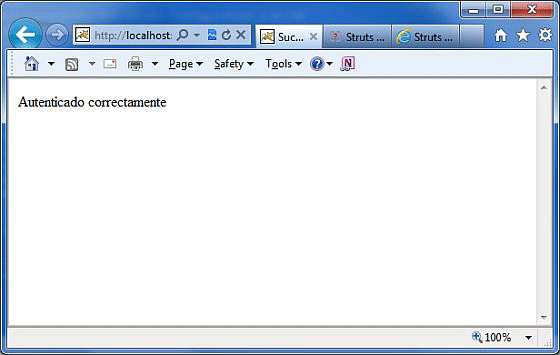Internationalization (i18n) is the process of planning and
implementing products and services so that they can easily be adapted to
specific local languages and cultures, a process called localization.
The internationalization process is sometimes called translation or
localization enablement.
Internationalization is abbreviated i18n because the word starts with an i and ends with an n, and there are 18 characters between the first i and the last n.
Struts2 provides localization ie. internationalization (i18n) support through resource bundles, interceptors and tag libraries in the following places:
The simplest naming format for a resource file is:
When you reference a message element by its key, Struts framework searches for a corresponding message bundle in the following order:
To display i18n text, use a call to getText in the property tag, or any other tag, such as the UI tags as follows:

Now select any of the languages, let us say we select Spanish, it would display the following result:

You can try with Franch language as well. Finally, let us try to click Submit button when we are in Spanish Locale, it would display the following screen:

Congratulations, now you have a multi-lingual webpage, you can launch your website globally.
Internationalization is abbreviated i18n because the word starts with an i and ends with an n, and there are 18 characters between the first i and the last n.
Struts2 provides localization ie. internationalization (i18n) support through resource bundles, interceptors and tag libraries in the following places:
- The UI Tags
- Messages and Errors.
- Within action classes.
Resource Bundles
Struts2 uses resource bundles to provide multiple language and locale options to the users of the web application. You don't need to worry about writing pages in different languages. All you have to do is to create a resource bundle for each language that you want. The resource bundles will contain titles, messages, and other text in the language of your user. Resource bundles are the file that contains the key/value pairs for the default language of your application.The simplest naming format for a resource file is:
bundlename_language_country.propertiesHere bundlename could be ActionClass, Interface, SuperClass, Model, Package, Global resource properties. Next part language_country represents the country locale for example Spanish (Spain) locale is represented by es_ES and English (United States) locale is represented by en_US etc. Here you can skip country part which is optional.
When you reference a message element by its key, Struts framework searches for a corresponding message bundle in the following order:
- ActionClass.properties
- Interface.properties
- SuperClass.properties
- model.properties
- package.properties
- struts.properties
- global.properties
- global.properties: By default English (United States) will be applied
- global_fr.properties: This will be used for Franch locale.
- global_es.properties: This will be used for Spanish locale.
Access the messages
There are several ways to access the message resources, including getText, the text tag, key attribute of UI tags, and the i18n tag. Let us see them in brief:To display i18n text, use a call to getText in the property tag, or any other tag, such as the UI tags as follows:
<s:property value="getText('some.key')" />The text tag retrieves a message from the default resource bundle ie. struts.properties
<s:text name="some.key" />The i18n tag pushes an arbitrary resource bundle on to the value stack. Other tags within the scope of the i18n tag can display messages from that resource bundle:
<s:i18n name="some.package.bundle"> <s:text name="some.key" /> </s:i18n>The key attribute of most UI tags can be used to retrieve a message from a resource bundle:
<s:textfield key="some.key" name="textfieldName"/>
Localization Example
Let us target to create index.jsp from the previous chapter in multiple languages. Same file would be written as follows:<%@ page language="java" contentType="text/html; charset=ISO-8859-1" pageEncoding="ISO-8859-1"%> <%@ taglib prefix="s" uri="/struts-tags"%> <!DOCTYPE html PUBLIC "-//W3C//DTD HTML 4.01 Transitional//EN" "http://www.w3.org/TR/html4/loose.dtd"> <html> <head> <title>Employee Form with Multilingual Support</title> </head> <body> <h1><s:text name="global.heading"/></h1> <s:url id="indexEN" namespace="/" action="locale" > <s:param name="request_locale" >en</s:param> </s:url> <s:url id="indexES" namespace="/" action="locale" > <s:param name="request_locale" >es</s:param> </s:url> <s:url id="indexFR" namespace="/" action="locale" > <s:param name="request_locale" >fr</s:param> </s:url> <s:a href="%{indexEN}" >English</s:a> <s:a href="%{indexES}" >Spanish</s:a> <s:a href="%{indexFR}" >France</s:a> <s:form action="empinfo" method="post" namespace="/"> <s:textfield name="name" key="global.name" size="20" /> <s:textfield name="age" key="global.age" size="20" /> <s:submit name="submit" key="global.submit" /> </s:form> </body> </html>We will create success.jsp file which will be invoked in case defined action returns SUCCESS.
<%@ page language="java" contentType="text/html; charset=ISO-8859-1" pageEncoding="ISO-8859-1"%> <%@ taglib prefix="s" uri="/struts-tags"%> <!DOCTYPE html PUBLIC "-//W3C//DTD HTML 4.01 Transitional//EN" "http://www.w3.org/TR/html4/loose.dtd"> <html> <head> <title>Success</title> </head> <body> <s:property value="getText('global.success')" /> </body> </html>Here we would need to create following two actions. (a) First action a to take care of Locale and display same index.jsp file with different language (b) Another action is to take care of submitting form itself. Both the actions will return SUCCESS, but we will take different actions based on return values because our purpose is different for both the actions:
Action to take care of Locale
package com.tutorialspoint.struts2; import com.opensymphony.xwork2.ActionSupport; public class Locale extends ActionSupport{ public String execute() { return SUCCESS; } }
Action to submit the form
package com.tutorialspoint.struts2; import com.opensymphony.xwork2.ActionSupport; public class Employee extends ActionSupport{ private String name; private int age; public String execute() { return SUCCESS; } public String getName() { return name; } public void setName(String name) { this.name = name; } public int getAge() { return age; } public void setAge(int age) { this.age = age; } }Now. let us create following three global.properties files and put the in CLASSPATH:
global.properties
global.name = Name global.age = Age global.submit = Submit global.heading = Select Locale global.success = Successfully authenticated
global_fr.properties
global.name = Nom d'utilisateur global.age = l'âge global.submit = Soumettre des global.heading = Sé lectionnez Local global.success = Authentifi é avec succès
global_es.properties
global.name = Nombre de usuario global.age = Edad global.submit = Presentar global.heading = seleccionar la configuracion regional global.success = Autenticado correctamenteWe will create our struts.xml with two actions as follows:
<?xml version="1.0" encoding="UTF-8"?> <!DOCTYPE struts PUBLIC "-//Apache Software Foundation//DTD Struts Configuration 2.0//EN" "http://struts.apache.org/dtds/struts-2.0.dtd"> <struts> <constant name="struts.devMode" value="true" /> <constant name="struts.custom.i18n.resources" value="global" /> <package name="helloworld" extends="struts-default" namespace="/"> <action name="empinfo" class="com.tutorialspoint.struts2.Employee" method="execute"> <result name="input">/index.jsp</result> <result name="success">/success.jsp</result> </action> <action name="locale" class="com.tutorialspoint.struts2.Locale" method="execute"> <result name="success">/index.jsp</result> </action> </package> </struts>Following is the content of web.xml file:
<?xml version="1.0" encoding="UTF-8"?> <web-app xmlns:xsi="http://www.w3.org/2001/XMLSchema-instance" xmlns="http://java.sun.com/xml/ns/javaee" xmlns:web="http://java.sun.com/xml/ns/javaee/web-app_2_5.xsd" xsi:schemaLocation="http://java.sun.com/xml/ns/javaee http://java.sun.com/xml/ns/javaee/web-app_3_0.xsd" id="WebApp_ID" version="3.0"> <display-name>Struts 2</display-name> <welcome-file-list> <welcome-file>index.jsp</welcome-file> </welcome-file-list> <filter> <filter-name>struts2</filter-name> <filter-class> org.apache.struts2.dispatcher.FilterDispatcher </filter-class> </filter> <filter-mapping> <filter-name>struts2</filter-name> <url-pattern>/*</url-pattern> </filter-mapping> </web-app>Now, right click on the project name and click Export > WAR File to create a War file. Then deploy this WAR in the Tomcat's webapps directory. Finally, start Tomcat server and try to access URL http://localhost:8080/HelloWorldStruts2/index.jsp. This will give you following screen:




No comments:
Post a Comment